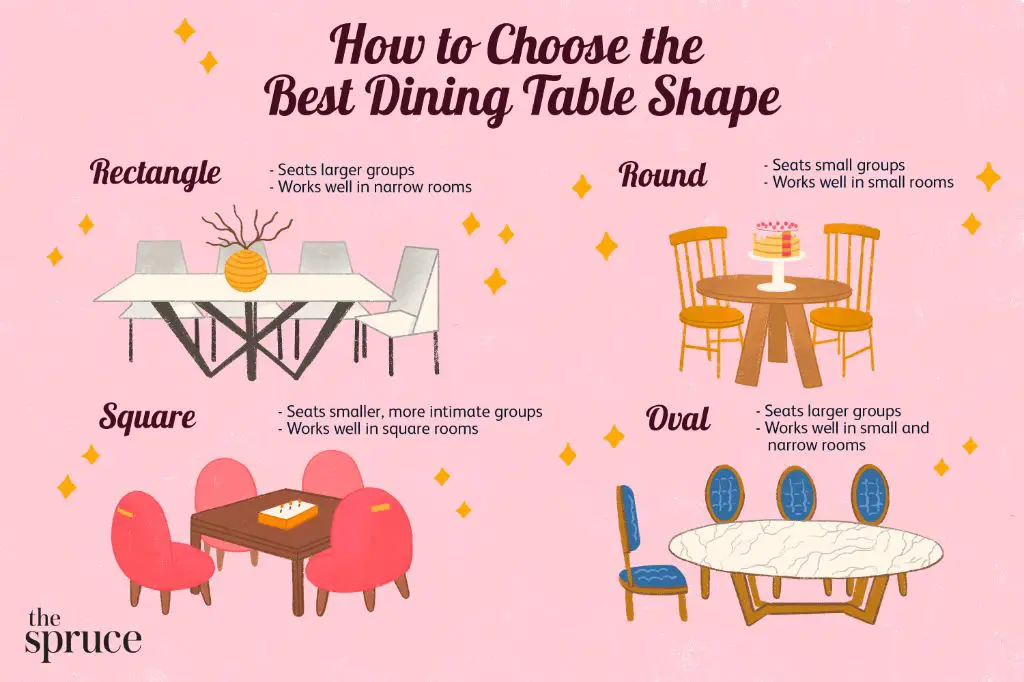What Are Typical Dining Room Tables?
Dining room tables are an integral part of the home that serve many purposes beyond just eating meals. The dining table is often the central focus of the dining room and one of the most used spaces for gathering family and friends. It provides a place not just for eating, but also for conversation, games, doing homework, crafts, and celebrations. The style and size of the dining table help set the tone for the room and accommodate the needs of the household.
Materials
Some of the most common materials used for dining room tables include:
Wood
Wood is a very popular material for dining tables. Many prefer the natural beauty and warmth of wood. Common woods used include oak, maple, walnut, cherry, and mahogany. Wood table tops can have different finishes and stains to complement any dining room décor.
Glass
Glass dining tables have a light and airy aesthetic. The transparent table top creates the illusion of more space. Glass tables often have a metal base for support. Tempered glass is used for safety and durability.
Metal
Metal dining tables are modern, durable, and low maintenance. Stylish metals like stainless steel, brass, and chrome are commonly used. Metal tables can have a clean, industrial vibe or be mixed with other materials for eclectic style.
Styles
Dining room tables come in a variety of styles including traditional, modern, and transitional:
Traditional styles have more ornate details like turned legs, carved surfaces, and decorative finishes. They often feature darker woods like mahogany or cherry. Traditional dining tables have an elegant and formal aesthetic.
Modern styles use clean lines, simple forms, and lighter finishes. They incorporate newer materials like glass, metal, and acrylic. Modern dining tables have a sleek and contemporary look.
Transitional styles blend elements of traditional and modern design. They often have tapered legs, neutral finishes, and minimal ornamentation. Transitional dining tables have an updated classic style.
The style of dining table can set the tone for the whole dining room decor. Traditional styles match formal settings while modern and transitional styles work in more casual spaces. The table style should coordinate with the overall interior design of the home.
(Source: https://www.homesquare.com/Buy-Dining-Room-Furniture–p1.htm)
Shapes

The most common shapes for dining room tables are rectangular, round, and oval.1,2
Rectangular dining tables are the most popular shape. They work well in elongated dining spaces and allow you to fit more chairs around the table. Rectangular tables can come with straight edges or rounded corners.
Round dining tables are great for smaller spaces as they take up less visual space. They promote conversation since all seats face each other. Round tables work well with 4-6 chairs.
Oval dining tables are similar to round but allow you to fit more chairs around the table. They work well in small dining rooms.
Sizes
Standard dining table sizes depend on the number of people the table needs to seat. Here are some common sizes:
For 4 people, a dining table width of 68-72 inches (about 5.5-6 feet) is typical (Source). This allows for about 18-24 inches per person.
For 6 people, a width of 72-80 inches (6-6.5 feet) is standard. This provides 24-30 inches per person (Source).
For 8 people, a width of 80-92 inches (around 7-8 feet) is common. This allows 24-28 inches per diner.
Some standard depths are 30-36 inches for smaller tables and 36-48 inches for larger ones seating 6-8 people.
Features
Some common features of dining room tables include:
Extendable – Many modern dining tables have leaves that can be inserted into the table to extend it, allowing it to accommodate more people. This is useful for holidays or dinner parties when extra seating is needed. Extendable tables may add 12-18 inches per leaf.
Foldable – Foldable or drop-leaf dining tables have hinged leaves that can be raised or lowered as needed. When folded down, the table takes up less space against a wall or in storage. Foldable tables are convenient for smaller dining spaces.
Self-storing – Some dining tables have self-storing leaves that slide inside the table when not in use. This allows the table to expand while keeping the leaves out of sight and out of the way when folded.
According to “The must-have characteristics of dining tables” (source), extendable and foldable options allow dining tables to adapt to the size of the room and number of diners.
Finishes
Dining table finishes can dramatically affect the look and feel of the table. Popular options include:
- Stains – Allow the natural wood grain to show through while coloring the wood. Stains come in a range of hues from light natural tones to dark espresso colors. Stains protect the wood while accentuating its inherent beauty. Popular wood stains include cherry, oak, walnut, and mahogany.
- Paints – Completely cover the wood in an opaque solid color or faux finish. The most common dining table paint colors are white, black, gray, and neutrals. Painted finishes provide a clean, modern look.
- Glossy vs. Matte – Glossy finishes have a shiny, reflective surface while matte is low sheen and smooth. Glossy finishes tend to highlight imperfections while matte downplays them. Glossy has a glamorous appeal while matte is more casual and understated.
Consider the design of the table and the overall room decor when selecting a dining table finish. The finish impacts both aesthetics and practicality in terms of wear and tear.
Chairs
Dining chairs come in a variety of styles. The two main types are arm chairs and side chairs. Arm chairs have armrests on each side, while side chairs do not. Arm chairs are usually placed at the ends of the table. Here are some of the most common dining chair styles:
Upholstered vs. Wooden – Upholstered chairs have padded seats and backs covered in fabric or leather. Wooden chairs have seats and backs made of solid wood or wood veneers. Upholstered chairs provide more comfort while wooden chairs have a more timeless, traditional look.
Back Styles – Some common back styles for dining chairs include slat backs, which have horizontal slats; ladder backs, which have vertical slats; splat backs, which have a central vertical slat with horizontal slats on the sides; and x-backs with crisscrossing slats.[1]
Arm Styles – Arm chairs may have upholstered arms, wooden arms, rolled/curved arms, straight arms, or no arms at all. The arm style impacts both the look and comfort.
Leg Styles – Legs can be tapered, straight, or curved. Materials include wood, metal, or upholstered legs. The leg style affects the overall visual weight and styling.
Modern vs. Traditional – Modern dining chairs tend to have sleek, low profiles and minimalist designs. Traditional styles have more ornate details and often draw inspiration from past furniture eras.
Placement
When placing a dining room table, you’ll want to consider its proximity to the kitchen as well as lighting and spacing in the room. Here are some tips for optimal table placement:
Proximity to Kitchen – It’s convenient to have the dining table relatively close to the kitchen, so food doesn’t have to travel a long distance from stove to table. But make sure there’s still enough space between the kitchen and dining area so people aren’t crowded when cooking and prepping food.
Lighting – Position the table near a light source, such as a hanging pendant or chandelier above the table, or consider placing it near a window to utilize natural light during daytime meals. Proper lighting creates an inviting atmosphere.
Spacing – Allow ample space around the dining table for people to pull out chairs and walk around without bumping into furniture. A minimum of 36-42 inches around the table is usually suitable. Also consider traffic flow in the room so the table doesn’t obstruct main walking paths.
Feng shui principles suggest placing the dining table in a command position where the seating faces the entrance to the room, but not directly in line with it. This allows diners to see who’s entering while avoiding an overly confrontational placement.
Costs
The cost of a dining room table can vary significantly depending on the materials, quality, size and style. Here is an overview of typical budget and high-end pricing:
Budget dining tables often cost $200-$1000. These tend to be made from cheaper woods like pine or rubberwood, have a basic rectangular shape, and standard finishing. For example, a simple 6-person rectangular table may cost $300 from budget retailers like IKEA or Walmart.
Mid-range dining tables cost $1000-$3000. These are often made from stained oak or other harder woods, with some decorative elements like turned legs or inlaid designs. A mid-range 6-person pedestal table may cost around $1500.
High-end dining tables run $3000-$20,000 and up. They are constructed from fine woods like mahogany or walnut, with intricate carvings, exotic veneers, or luxury finishes. A large 12-person formal dining table could cost $10,000 from upscale designers.
Additional factors like extension leaves, benches, chairs, and integrated storage can add even more to the total cost. But in general, expect to spend $500-$5000 for a quality dining table suitable for most homes.

